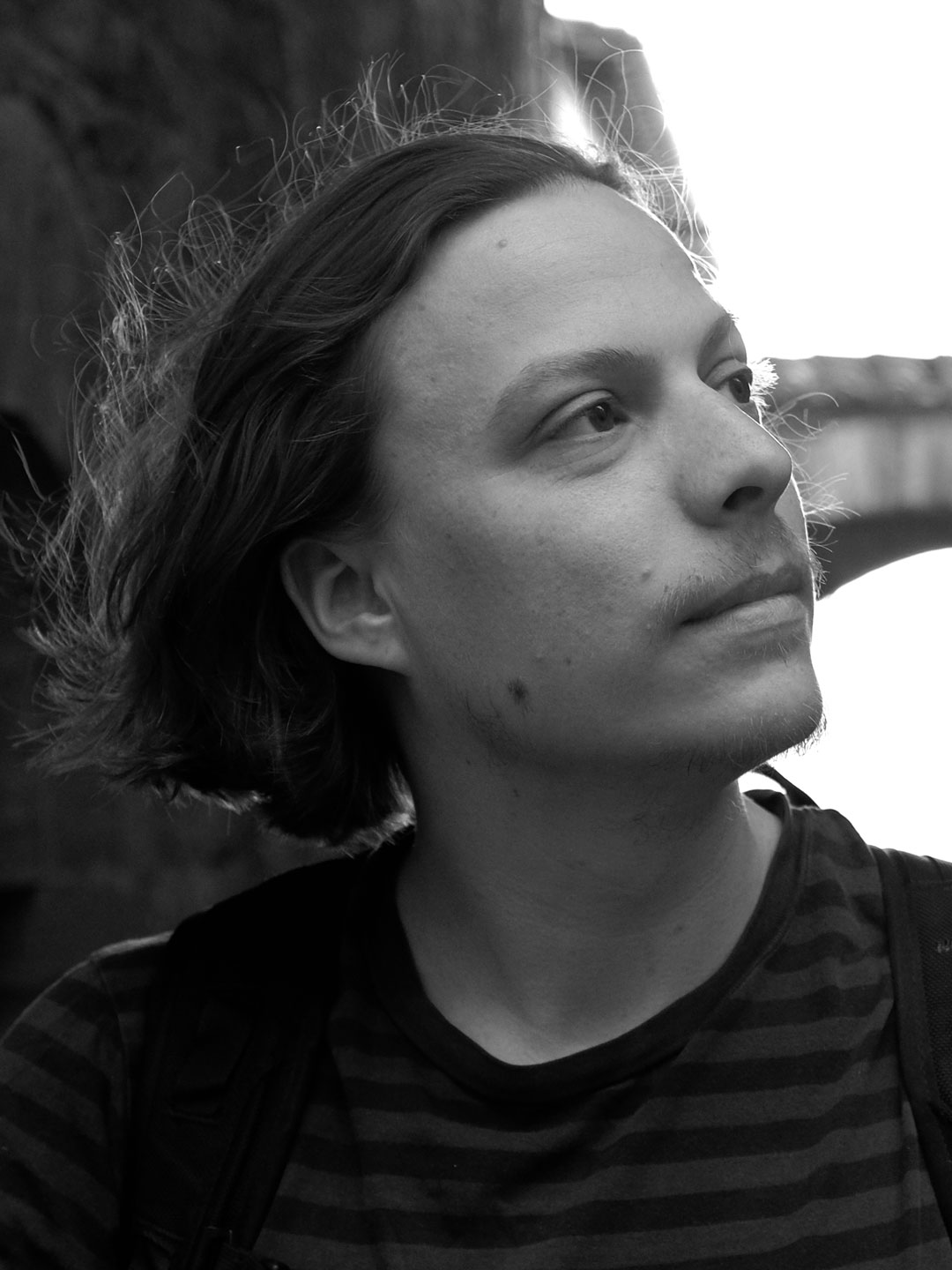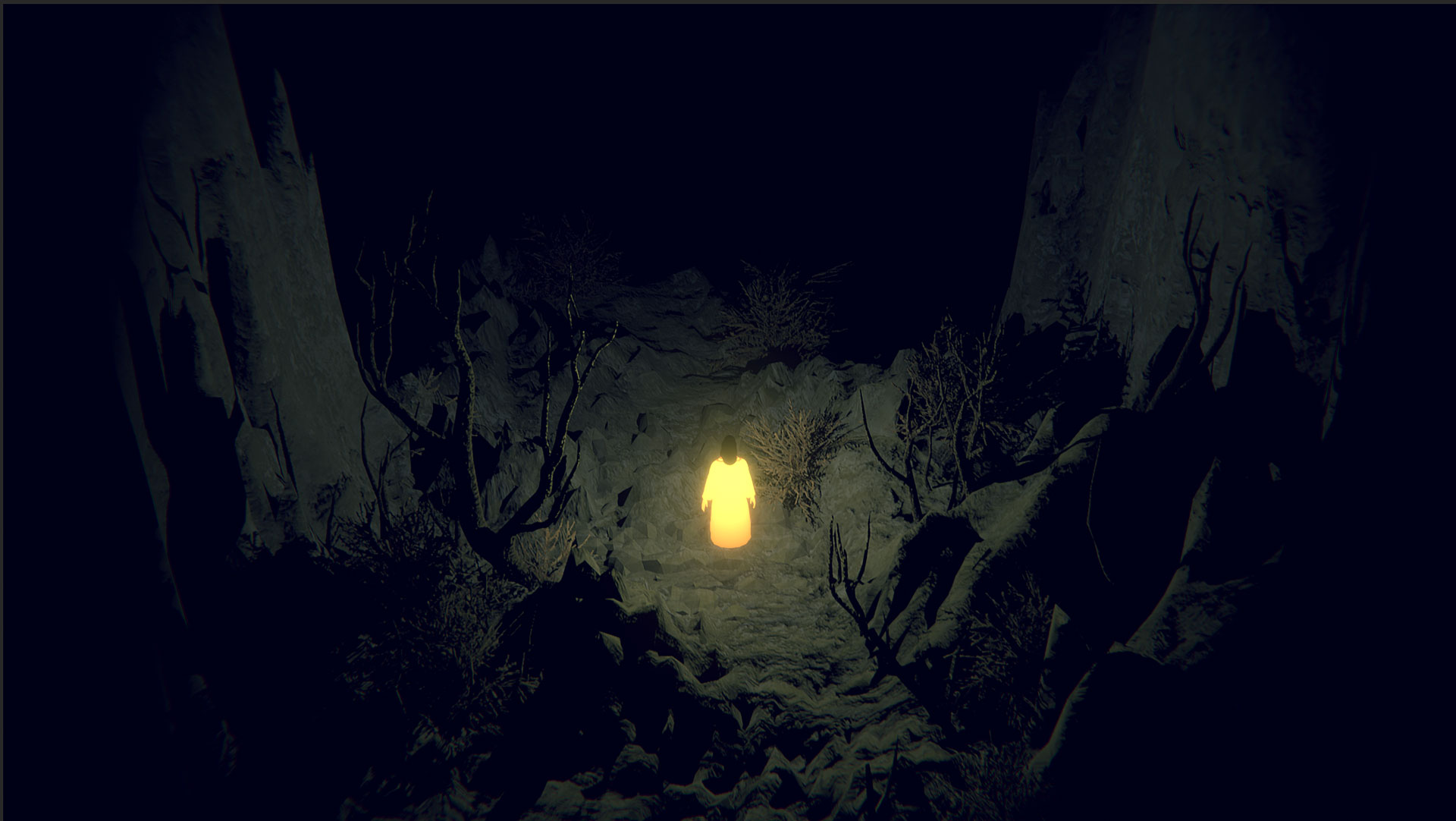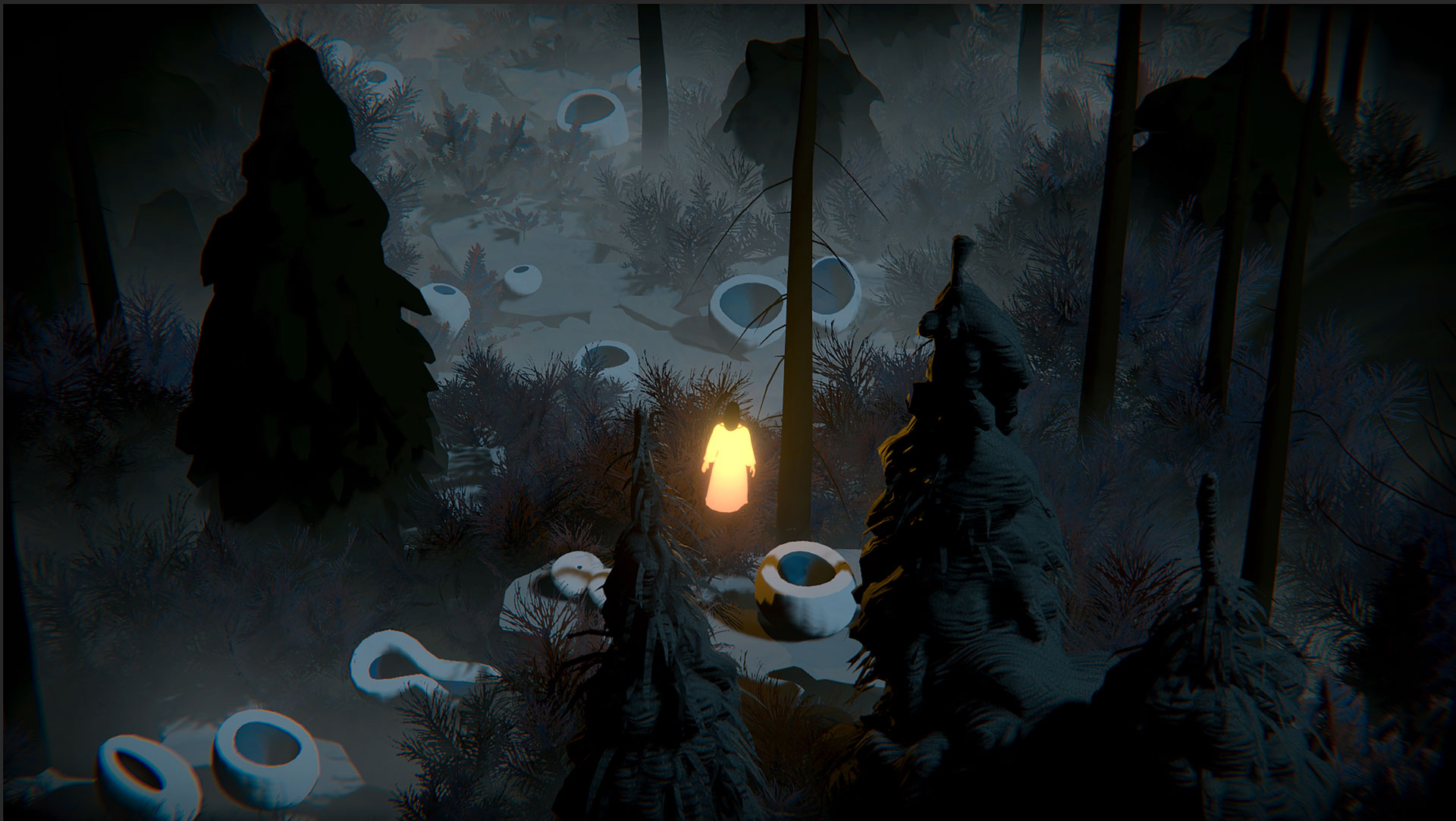Throw caution to the wind and the universe will follow
Mads Vadsholt’s creative process designing games

WeAnimate 2024-01-08 | wam#0025
Digital artist and composer Mads Vadsholt is a graduate of The Animation Workshop (TAW) and a member of the eclectic artist hub PLASTIC Art Collective based in Viborg, Denmark. Vadsholt has collaborated on many recent Danish animation and game projects and is nearly done completing his first independent game, The Forest Quartet. The Forest Quartet is a beautiful, story-driven puzzle game where you play the spirit of a deceased singer restoring the band to play a farewell concert. The game has been recognized and supported by The Danish Film Institute, Danish Arts Foundation, Stugan, and more. We recently spoke with Vadsholt about his creative process and what we can expect from the game.
WeAnimate Magazine: You started as an illustrator and graffiti artist, and then things changed for you at The Animation Workshop.
Mads Vadsholt: I was still a teenager when I enrolled at The Animation Workshop, and I was really into drawing and my creative process. I imagined that school would be sitting around and drawing every day, but instead, it was using software all the time. The school requires you to master the technical stuff before they let you do creative stuff, and it was hard for me to understand why I had to learn all these things or see the long-term benefits. I wanted to be more hands-on, and I made life hard for all the instructors and coordinators because I wanted to focus on drawing instead of learning Maya.
You had to finish each assignment on time, or you were behind for the next assignment, and I didn’t have as much discipline as the other students. For the first semester, I had to redo my biggest first-semester assignment, while still working on the assignments for the second semester, and it was hard.
But around that time I started understanding that work in 3D could be creative and interesting. I started to see that you could have fun with it, that there were ways to explore and break the rules. I liked rendering, where I could set up the lights and produce something amazing, so I slowly transitioned from being a concept artist to becoming a 3D artist.
Our bachelor project was to make an iPad game (Lost Tracks, directed by Morten Andersen), and I thought it was an interesting project. Game development was really interesting to me. It’s so interesting to watch people play your artwork, rather than watch your artwork. It’s far more enjoyable as a creator to feel how people respond and listen to how they talk about your work in real-time, as they encounter it.
Game design also has interesting psychological aspects: you want to tell people what to do, but you don’t want to put some lame talking bird on their shoulder delivering instructions. The experience of watching people intuitively understand what they need to do and how to interact with the game, without any dialogue, and without a helping hand, was very interesting for me. We only had three words in the whole game, but people got it anyway.
It was a cool team and we had a good time working together on those late nights, so it was a positive experience. It helped me understand how to make a good game.
WA: Tell us more about your inspiration for The Forest Quartet.
MV: I am a musician, and so is my father, which was one of the original inspirations for the game. My father is a jazz musician, and my mother, who was a singer, passed away. So although the game isn’t my life story, it’s still extremely personal and based on my experiences. I composed some of the early songs myself, and in the beginning, I thought it would be this cool electronic music. Over time I purified the concept, and it made more sense for them to be a jazz band with four musicians. Since I’m not a jazz composer, my father helped create the music for the game.
I’ve been working on it since early 2016, and I’m still working on it. In retrospect, it was naive for me to finish school, do my internship, and then think I was ready to make my masterpiece project. It was so ambitious for someone who had so little experience and resources to tell myself that I would make this masterpiece game and it would make me famous.
I haven’t worked on it continuously, because I’ve worked on freelance projects in between. Of course, even if you aren’t “working on it”, you’re still working on it, because it’s in the back of your mind every day. This game has been bugging me for five years. If I spent a month on a paid project, I would start to feel restless and eager to return to my game, or if I took a holiday I would start worrying about getting back to the game.
Working on the game was very unstable: the first couple of years were a lot of sacrifices. I had very little money or security. I started at my grandmother’s house so I could work on it without worrying about earning money. Sometimes a friend would come for a weekend and help me out with something, and then I would scramble together an application for the Danish Film Institute. It would take two weeks of 15 hour days, just writing my application and getting feedback and hoping to get funding. I sent off the first application and got refused, so suddenly I was broke and homeless and had no idea where to get money… that summer felt very lost. It felt very floaty, without a stable base.
Then I got more connections for freelance work and started to get some paying jobs that helped me be more stable and have more faith that things would eventually work out.
WA: How did you stay motivated to keep working despite all those early setbacks?
MV: I’m so committed to the idea that this is my masterpiece project, and I can’t change how I feel about it. That helped me stay committed to my vision even during that hard time. It’s important for me that it is not just a project that you do for fun, or that it’s not just a hobby. I would have quit three years ago if I was just making any game. I would have either released just an ordinary game for the basic experience or simply walked away from the whole thing. But because I am so stubborn about what this project means to me, giving up on it would be like giving up on myself. It’s part of my identity.
Because I am so stubborn about what this project means to me, giving up on it would be like giving up on myself.
Mads Vadsholt

I wrote three funding applications over two years, and the third one was successful. Over time, I started understanding what the DFI wanted from my applications and learning what they respond to. In the beginning, all my applications were like, “I’m not doing this for the money, you guys! This is an artistic project, and it’s very emotional for me” and that didn’t help at all. They want to see a project plan that makes sense and will get finished. I had to learn what I could sell the game on, and simplify the application and lean on that.
I’m almost glad I didn’t get funding in those early stages. It was too chaotic, and I wouldn’t yet have been good at managing finances and a team. I ended up getting money at the right time. Now we are in late development, and it will take another year to finish. People can look for it in the spring of 2022.
WA: What’s your favorite part of developing your own game?
MV: The part where people are playing the game and reacting to it can be really fun, but it can also cause a lot of suffering. I would work on a prototype for a couple of months, and then share it with my friends, and I could see that they weren’t feeling it. That alone was proof for me that it wasn’t yet a masterpiece, so I would have to scrap all that work and start over. Now we have a better game and people are enjoying it, but I’m still seeing some things that need to change and could be better.
I love the thought process behind figuring things out and solving problems. You have this set of game mechanics and framework that defines the game, and then you have to figure out how to use it, reinforcing it for the player. Working within those limitations, sitting at home and sketching ideas, and figuring out new ways to use and build on what I already have, is so cool.
For example, the player character can fly and kind of glide around. There are a few times when she has to jump up on something and glide down. It’s nice, but not essential to the game.
The game is divided into three acts: there are three forests, with one band member in each forest. The first act is a depressed pianist, the second act is the anxious bassist, and the third act is the angry drummer. The first act has this depressed forest, with fungus and visual design that makes it feel gloomy, in order to make the player feel a certain mood when playing this part of the game. Then they get to experience the contrast of turning the forest green again when it comes back. The second act has a very dark forest for anxiety. It’s not hard to evoke that feeling; there is spiky stuff and darkness and mystery.
As I was recently working on the second act, I was working on the part where the player spawns in the forest. They spawn at a high point in the dark world, and the player character is the sole light source, so you get that creepy feeling like you’re walking around in complete darkness with a flashlight. The player has to jump off the ledge, with no idea of where they are or what comes next. It’s an incredibly effective, creepy moment, and it was free since I already had the flying/gliding mechanic working. Nobody had to code it or implement it or make it – we already had it and it worked perfectly.
Normally when I have an idea I have to hire someone and they work for three months and we figure out that it doesn’t work and we have to scrap the idea and waste all that time and money. At least you know that it doesn’t work and you can cross it off the list, but it still feels like a waste. But when I can find a way to reuse and reinforce what I already have, like the gliding mechanic, to get something cool and effective out of the framework we’ve already created, it’s incredibly satisfying.
Finally, I like just chilling and listening to music while placing environmental assets. I place a tree and look at it and rotate it, then add a bush… it’s very nice and peaceful. When I do that, I need to be calm and uninterrupted, so it’s a good way for me to take a break from the more demanding aspects of leading a project and running a company, and create relaxing time for myself.
WA: And what’s your least favorite part?
MV: Doing the monkey work. There are all kinds of boring, repetitive, chore-type tasks that need to be done but don’t engage or excite me. I mean, when you do household chores like laundry or washing dishes, it takes some effort and isn’t fun, but you feel good afterward. But there are some boring repetitive tasks in Unity that don’t have that reward afterward – you do it and you hate it and when it’s done you don’t feel good. You just have to grind through renaming a thousand files or something and get it done with.
I also don’t like coming back to the project after being away from it for a couple of months. It’s so uncomfortable it’s horrendous. You have to look back over everything, trying to remember what you were doing and why, what that C# script was doing, is this a new or old asset, is this even fun, is this all a bad idea? It’s awful. That’s why you need to keep a clean project so that you can go back in and look at all the tasks and remember where you were and why.
The first act has this depressed forest, with fungus and visual design that makes it feel gloomy, in order to make the player feel a certain mood.
Mads Vadsholt
I also dislike being a boss. I don’t like telling people to come to work on time or do better work. I don’t mind giving criticism when it’s fair. I think we didn’t do enough of that at TAW, because we were so focused on supporting each other. All our criticism was wrapped in paper and delivered very gently. I like being honest and telling people when their work isn’t good enough because I feel like I’m challenging them and helping them grow. But there have been instances where working with someone and being their friend at the same time starts to feel like a distraction from the actual work I want us to be doing. Managing people every day can be hard, and in a perfect world, there would be someone else on the project doing it instead of me.
WA: If Forest Quartet is your masterpiece, what can possibly come after that? What’s next?
MV: [laughs] Yeah, so I’ll complete my whole life’s work at the age of 29. I know that’s naive. But time will tell what happens next.
Over the process of making this project, it’s been surprising that the aspects of it that I thought was great at the beginning don’t seem so great anymore, and the things I thought I was good at aren’t really what I’m good at after all; I’m better at other things. I’ve learned so much and there have been so many surprises.
I have also been surprised by how much I like teaching. It’s refreshing to take things I’ve learned as a professional, and then take them and give them out to someone else and help them learn. It’s really beautiful. It’s very giving to teach, to be able to say eight words and open new doors for someone, or spend two hours and help change someone’s life. Teaching is one of the most meaningful work experiences I’ve had so far.
For me to dedicate time and energy to a new independent game project, I would require solid financial security and a more coherent team from the get-go. During The Forest Quartet, I’ve had so many different people coming and going over time, and it causes confusion and lost time. There were also too many times where I had to stop working on the project because I needed to do something else to earn money. In my 30s, I want to have more security and less stress, to make a great game, and still have a life of my own.
WA: Do you have any advice for people who are just starting out?
MV: Try to find a solid base for yourself. Having just a little part-time job, or regular freelance work, so you know you have enough money for rent and food, gives you enough security and stability to engage in your big creative work. Having people near you who love and support you is also incredibly important for your security.
When you are working on your passion project, it’s very emotional and chaotic and can go in all kinds of different directions. When you also feel like your life is chaotic, and you have no idea what’s going on, it makes it incredibly difficult. Postpone your dream project until you have some stability.
Finally, trust in the universe. There are times when I was in despair and didn’t know what was going to happen, and then somehow I would get just the money I needed or just the support that would help at that time. That happened enough times over these five years that I have come to believe in it. You need to relax and trust that things will come together for you, as long as you are doing the hard work and taking care of whatever you need to take care of. Trust in yourself, and do the stuff you said you would do. My friend Pelle once said, “Be true to yourself and your surroundings will adapt.” It didn’t make sense to me at the time, but it seems to be true.


Credits
Words: Rebekah Villon
Website: www.madsvadsholt.site
Profile on PLASTIC Art Collective (PAC): plasticcollective.dk/mads-vadsholt
The Forest Quartet (PAC):
plasticcollective.dk/the-forest-quartet
Collaborators

WeAnimate Magazine is dedicated to all the people who animate and make things, lines, and ideas come to life.
WeAnimate ApS is founded and owned by The Danish Animation Society (ANIS) www.anis.nu
Tell us what you think? Tell us at hello@weanimate.dk | #weanimate | our Privacy Policy